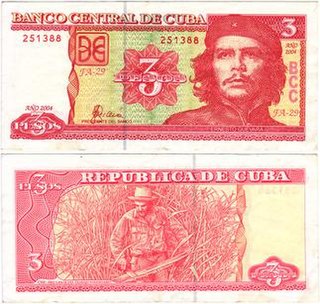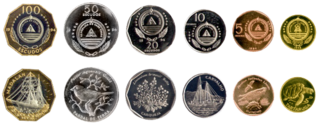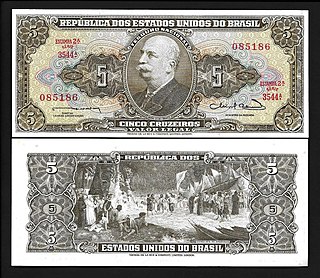The Mexican peso is the official currency of Mexico. The peso was first introduced in 1863, replacing the old Spanish colonial real. The Mexican peso is subdivided into 100 centavos, represented by "¢". Mexican banknotes are issued by the Bank of Mexico in various denominations and feature vibrant colors and imagery representing Mexican culture and history. Modern peso and dollar currencies have a common origin in the 16th–19th century Spanish dollar, most continuing to use its sign, "$".
The peso is the currency of Chile. The current peso has circulated since 1975, with a previous version circulating between 1817 and 1960. Its symbol is defined as a letter S with either one or two vertical bars superimposed prefixing the amount, $ or ; the single-bar symbol, available in most modern text systems, is almost always used. Both of these symbols are used by many currencies, most notably the United States dollar, and may be ambiguous without clarification, such as CLP$ or US$. The ISO 4217 code for the present peso is CLP. It was divided into 100 centavos until 31 May 1996, when the subdivision was formally eliminated. In July 2024, the exchange rate was around CLP940 to US$1.

The Philippine peso, also referred to by its Filipino name piso, is the official currency of the Philippines. It is subdivided into 100 sentimo, also called centavos.

The Portuguese escudo was the currency of Portugal from 22 May 1911 until the introduction of the euro on 1 January 2002. The escudo was subdivided into 100 centavos. The word escudo literally means shield; like other coins with similar names, it depicts the coat of arms of the state.

The Sucre was the currency of Ecuador between 1884 and 2000. Its ISO code was ECS and it was subdivided into 10 decimos and 100 centavos. The sucre was named after Latin American political leader Antonio José de Sucre. The currency was replaced by the United States dollar as a result of the 1998–99 financial crisis.
The centavo is a fractional monetary unit that represents one hundredth of a basic monetary unit in many countries around the world. The term comes from Latin centum, with the added suffix -avo ('portion').

The Cuban peso also known as moneda nacional, is the official currency of Cuba.

Philippine peso coins are issued by the Bangko Sentral ng Pilipinas for circulation in the Philippines and are currently available in seven denominations. The Philippine peso has been in use since Spanish rule.

The Dominican peso, officially the peso dominicano since 2010, is the currency of the Dominican Republic. Its symbol is "$", with "RD$" used when distinction from other pesos is required; its ISO 4217 code is "DOP". Each peso is divided into 100 centavos ("cents"), for which the ¢ symbol is used. With exception of the United States dollar, it is the only currency that is legal tender in the Dominican Republic for all monetary transactions, whether public or private.
The boliviano is the currency of Bolivia. It is divided into 100 cents or centavos in Spanish. Boliviano was also the name of the currency of Bolivia between 1864 and 1963. From April 2018, the manager of the Central Bank of Bolivia, Pablo Ramos, announced the introduction of the new family of banknotes of the Plurinational State of Bolivia, started with the 10 Bs note, and then gradually arrived to introduce the 200 Bs note, presented in April 2019. The new family of banknotes of the Plurinational State received several awards such as "the best banknotes in Latin America", was highlighted by its security measures, its aesthetics and its inclusion of prominent figures in Bolivian history, being among those who awarded the "Latin American High Security Printing Press Conference".

The escudo is the currency of the Republic of Cape Verde. One escudo is subdivided into one hundred centavos.

The peso was a currency of Venezuela until 1874. It was subdivided into 10 reales, each of 10 centavos.
Ecuadorian centavo coins were introduced in 2000 when Ecuador converted its currency from the sucre to the U.S. dollar. The coins are in denominations of 1, 5, 10, 25 and 50 centavos and are identical in size and value to their U.S. cent counterparts. They circulate within Ecuador alongside coins and banknotes from the United States. Although U.S. $1 coins are rarely used in the U.S., they are commonly used in Ecuador. Ecuador managed to introduce a $1 coin but finally decided to not release in common circulation, only in 2000 coin sets. Ecuador does not issue any banknotes, relying on U.S. issues.

This is an outline of Uruguay's monetary history. For the present currency of Uruguay, see Uruguayan peso.

The currency of Venezuela has been in circulation since the end of the 18th century. The present currency unit in Venezuela is the Venezuelan bolívar.
Currency in Colombia denotes the ingots, coins, and banknotes that have been used in Colombia since 1622. It was in that year, under a licence purchased from King Philip III of Spain, that Alonso Turrillo de Yebra established a mint at Santa Fe de Bogotá and a branch mint at Cartagena de las Indias, where gold cobs were produced as part of Colombia's first currency. Silver milled coins date from 1627. In 1831, Gran Colombia dissolved into Venezuela and New Granada. In 1836, in New Granada, new monetary laws were passed, to standardise the money produced in the country. From 1861 to 1862, due to financial instability, the United States of New Granada accepted British currency, the name of the country becoming the United States of Colombia in 1862. In 1880, Colombia pegged the peso to the gold standard due to the falling price of silver. In 1886, the paper peso was introduced. In 1931, Colombia abandoned the gold standard and switched to the current form of the peso.
This article provides a historical summary of the currency used in Ecuador. The present currency of Ecuador is the United States dollar.

The Philippine fifty-centavo coin (50¢) was a denomination of Philippine currency. It was minted for the Philippines from 1864 to 1994 and was demonetized in 1998.

The (first) cruzeiro was the official currency of Brazil from 1942 to 1967. It replaced the old real, which had been in use since colonial times, at the rate of Rs 1$000 = Cr$1, It was in turn replaced by the cruzeiro novo, at the rate of Cr$1,000 = NCr$1.
The Chilean peso was the legal tender of Chile from 1817 until 1960, when it was replaced by the escudo, a currency that was itself replaced in 1975 by a new peso.













